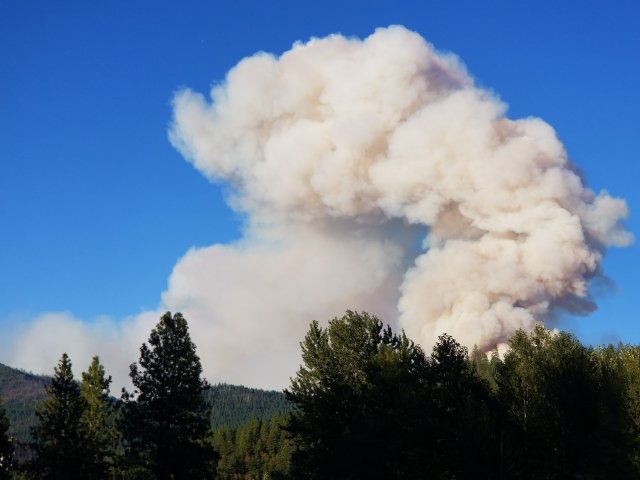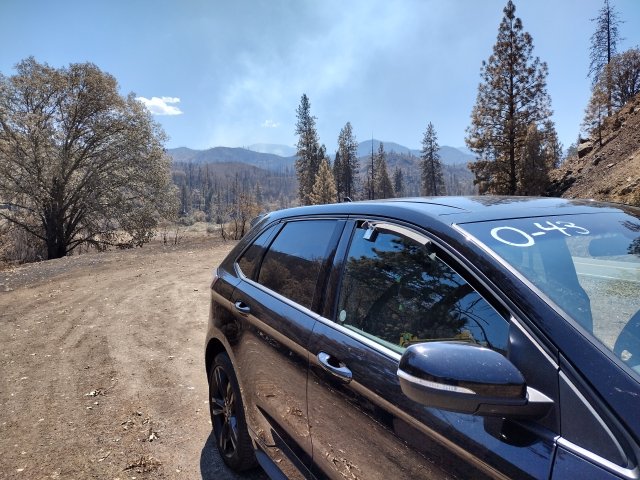EPA Scientist Serves as Air Resource Advisor on the McKinney Fire Modeling Smoke and Air Quality

Published January 17, 2023
In August 2022, a lightning-induced wildfire in Klamath National Forest in Northern California quickly grew to more than 50,000 acres in a matter of days. Soon after, EPA scientist Dr. John Iiames’ phone rang with a call for assistance.
This was hardly Iiames’ first wildfire response. In prior jobs he served as an initial attack wildland fire fighter for the State of Washington and for the U.S. Forest Service (USFS). This time though, Iiames traveled to Yreka, California, not to fight the fire directly but to use his expertise in air quality and smoke modeling to serve as an Air Resource Advisor (ARA) to the McKinney Fire Incident Command Team (ICT).

Iiames was one of two initial ARA’s onsite and worked 16-hour days over a period of two weeks to provide analysis and communication of smoke forecasts and impacts to incident teams, air quality regulators, and the public. A primary task of this position included producing a daily Smoke Outlook, which was distributed to local communities through the onsite public information officers and via the California Smoke Blog and the federal AirNow website.
Other responsibilities Iiames had as an ARA included the ordering, deployment, and maintenance of air monitor sampling systems around the incident area. On this fire, Iiames used a Vehicle Add-on Mobile Monitoring system (VAMMS) and Thingy AQ sensor system, both developed by EPA researchers. These two instruments collect data on levels of fine particulate matter (PM2.5) , carbon monoxide (CO), carbon dioxide (CO2), and total volatile organic compounds (VOCs).The Thingy AQ also measures CO, CO2, and VOCs.
Additionally, ARAs help monitor CO levels in the responders’ camps. On another fire incident in 2021, Iiames analysis of camp CO levels showed adverse levels close to working areas. This assessment informed the ICT to position tents and trailers a safe distance from the generators to protect their health.
A typical day as an ARA began at 4:30 a.m. with Iiames running and evaluating smoke models and assimilating other pertinent parameters about the fire such as vegetation burn type, fuel moisture content, wind speed, and PM2.5 estimates. ICT briefings at 7:00 a.m. discussed operations for the day including possible controlled fire operations to deprive the wildfire of additional fuel. By 8:00 a.m. Iiames sent the daily Smoke Outlook to the ICT, the California Air Resource Board, state and regional partners, then posted online for public access on EPA’s AirNow website. The rest of the day involved a mix of additional calls, meetings with community groups, and traveling to the fire to view the dispersion and different monitoring sites. For example, the VAMMS deployed in Iiames’ vehicle captured continuous PM2.5 data along the road and highway routes helping increase the information available to the ICT.
While at EPA, Iiames has served as an ARA on six wildfire incidents over four fire seasons. He emphasizes that the experience on these fires helps inform his wildland fire research.
Besides air pollution, water quality is another key environmental health concern during wildfire events that guides Iiames’ research. Runoff and erosion containing ash and fire retardant can negatively affect waterways. For example, on his second day at the McKinney Fire, a large thunderstorm dumped two inches of rain in under an hour causing significant ash and debris flow negatively affecting the tributaries. After the fire was under control, the USFS restored areas bulldozed as fire break-lines reducing surface area exposed to overland surface flow, thus reducing sedimentation and nutrification into the adjacent waterways. These first-hand experiences help create a more detailed understanding of the pathways for pollutants to spread, and of the people and processes involved in wildfire response from start to finish.
With his deployment complete and the fire under control, Dr. Iiames returned to EPA to continue his work in researching the (less flammable) burning questions about protecting human health and the environment.
